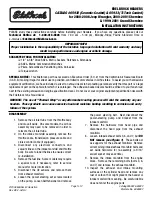
117
Things to remember when driving
Driving tips
Hills
To prevent overheating and the resulting
reduced efficiency of the brake system,
drive long or steep downhill gradients in the
gear in which the least braking is required. Even
light but consistent brake pressure can lead to
high temperatures, brake wear and possibly
even brake failure.
<
You can increase the engine's braking effect by
shifting down, all the way to first gear if neces-
sary. This strategy helps you avoid placing
excessive loads on the brake system. Down-
shifting in manual mode of the automatic
transmission, refer to page
.
Sport automatic transmission with double
clutch: never drive with the transmission
in neutral or with the engine switched off; other-
wise, there will be no engine braking action and
no power assistance to the brakes and steering.
Manual transmission: never drive with the
clutch held down, with the transmission in neu-
tral or with the engine switched off; otherwise,
there will be no engine braking action and no
power assistance to the brakes and steering.
Never allow floor mats, carpets or any other
objects to protrude into the area around the
pedals; otherwise, pedal function could be
impaired.
<
Corrosion on brake rotors
When the vehicle is driven only occasionally,
during extended periods when the vehicle is not
used at all, and in operating conditions where
brake applications are less frequent, there is an
increased tendency for corrosion to form on
rotors, while contaminants accumulate on the
brake pads. This occurs because the minimum
pressure which must be exerted by the pads
during brake applications to clean the rotors is
not reached.
Should corrosion form on the brake rotors, the
brakes will tend to respond with a pulsating
effect that even extended application will fail to
cure.
When the vehicle is parked
Condensation forms while the automatic
climate control is in operation, and then exits
under the vehicle. Traces of condensed water
under the vehicle are therefore normal.
Cargo loading
To avoid loading the tires beyond their
approved carrying capacity, never over-
load the vehicle. Overloading can lead to over-
heating and increases the rate at which damage
develops inside the tires. In some situations,
this can result in sudden loss of tire pressure.
<
Avoid fluid spills in the trunk as they could
damage the vehicle.
<
Determining loading limit
1.
Locate the following statement on your
vehicle's placard:
The combined weight of occupants
and cargo should never exceed
XXX kg or YYY lbs. Otherwise damage to
the vehicle may occur and unstable driving
conditions may result.
<
2.
Determine the combined weight of the
driver and passengers that will be riding in
your vehicle.
3.
Subtract the combined weight of the driver
and passengers from XXX kilograms or YYY
pounds.
4.
The resulting figure equals the available
amount of cargo and luggage load capacity.
For example, if the YYY amount equals
Online Edition for Part no. 01402911200 - © 06/13 BMW AG
Summary of Contents for 1 SERIES 2013
Page 10: ...9 Notes Online Edition for Part no 01402911200 06 13 BMW AG ...
Page 11: ...Online Edition for Part no 01402911200 06 13 BMW AG ...
Page 23: ...Online Edition for Part no 01402911200 06 13 BMW AG ...
Page 113: ...Online Edition for Part no 01402911200 06 13 BMW AG ...
Page 121: ...Online Edition for Part no 01402911200 06 13 BMW AG ...
Page 134: ...133 Professional radio Entertainment Online Edition for Part no 01402911200 06 13 BMW AG ...
Page 135: ...Online Edition for Part no 01402911200 06 13 BMW AG ...
Page 152: ...151 ConnectedDrive Communications Online Edition for Part no 01402911200 06 13 BMW AG ...
Page 153: ...Online Edition for Part no 01402911200 06 13 BMW AG ...
Page 201: ...Online Edition for Part no 01402911200 06 13 BMW AG ...
















































